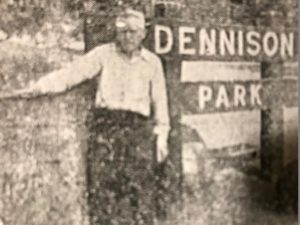The following article first appeared on June 6, 1961 in a newspaper that became the “Ojai Valley News”. The article is reprinted here with the permission of the “Ojai Valley News”. The author is Ed Wenig. Wenig wrote a series titled “Intangible Spirit of The Ojai”. He did not title each of his articles. Therefore, the “Ojai Valley Museum” has added “(No. 1)” to the title to distinguish it here from other articles with the same name.
Intangible Spirit of The Ojai (No. 1)
by
Ed Wenig

Beautiful, oak-covered Dennison Park is known throughout the Ojai Valley as a “family” park –– a place where people can come for quiet and rest. Earl Lively, park caretaker, points out that while other parks, by demand, have concessions in food and drinks and facilities for games and entertainment, there is only great natural beauty to lure the visitor to Dennison Park.
From the several lookouts on the 33 acre expanse at the top of the Dennison grade, one sees two entire Ojai Valleys — Lower and the Upper — simply by turning around. It is no wonder that in 1924, when the Dennison family deeded the property to the county the local paper stated, “A more beautiful and charming park site could not be found in the county.”
There is some significance to the picture above showing Mr. Lively pointing to a spot on the huge rock at the park entrance. For he, along with members or the Dennison family and other pioneers have often wondered why the plaque that was promised by the supervisors of 1924 was never made, or, if made, was never fastened to the rock 37 years ago.
In 1924, the year the county supervisors accepted the property as a park, and Tom McGuire of the Upper Ojai was ordered by the Board to bring this 40-ton rock from the east to the west side of the new grade road, as a unique and permanent entrance marker. “This I did,” said McGuire recently, “and what a job it was for my cat of that year! I understood that a special bronze plate was to be securely fastened to the rock explaining, and commemorating the generous gift of the Dennison family. Why it was never completed I, nor anyone else, has ever found out.”
According to Mr. Lively, the park site seems to have been a favorite camping place and home for at least three different and unrelated Indian cultures. While historians may write their speculations of the long, unrecorded past, Mr. Lively takes pleasure in showing visitors the mortars on a huge rock made undoubtedly by the Oak Grove Indians, the first Indian culture of 10,000 or more years ago. Then he describes the second culture, the so-called Hunter Indians, who, with bow and arrow and stone ax were able to hunt large animals for food, clothing and housing.
But when caretaker Lively talks about the third Indian culture, the Canalinos or Chumash, a note of sadness creeps into his voice. “With the coming of the white man, with his impatience, his faster way of living, and his disregard of nature’s balance, the Chumash disappeared. But, with real enthusiasm, Lively concluded: “I Like Dennison Park. It’s still a little world all of its own, high up here between two lovely valleys, just as it was for the Oak Grove, the Hunters, and the Chumash. When I occasionally find artifacts of one or the other of the three cultures, I go back in my imagination to the days of long ago when this little mountain top was a real paradise for the Indians.”
